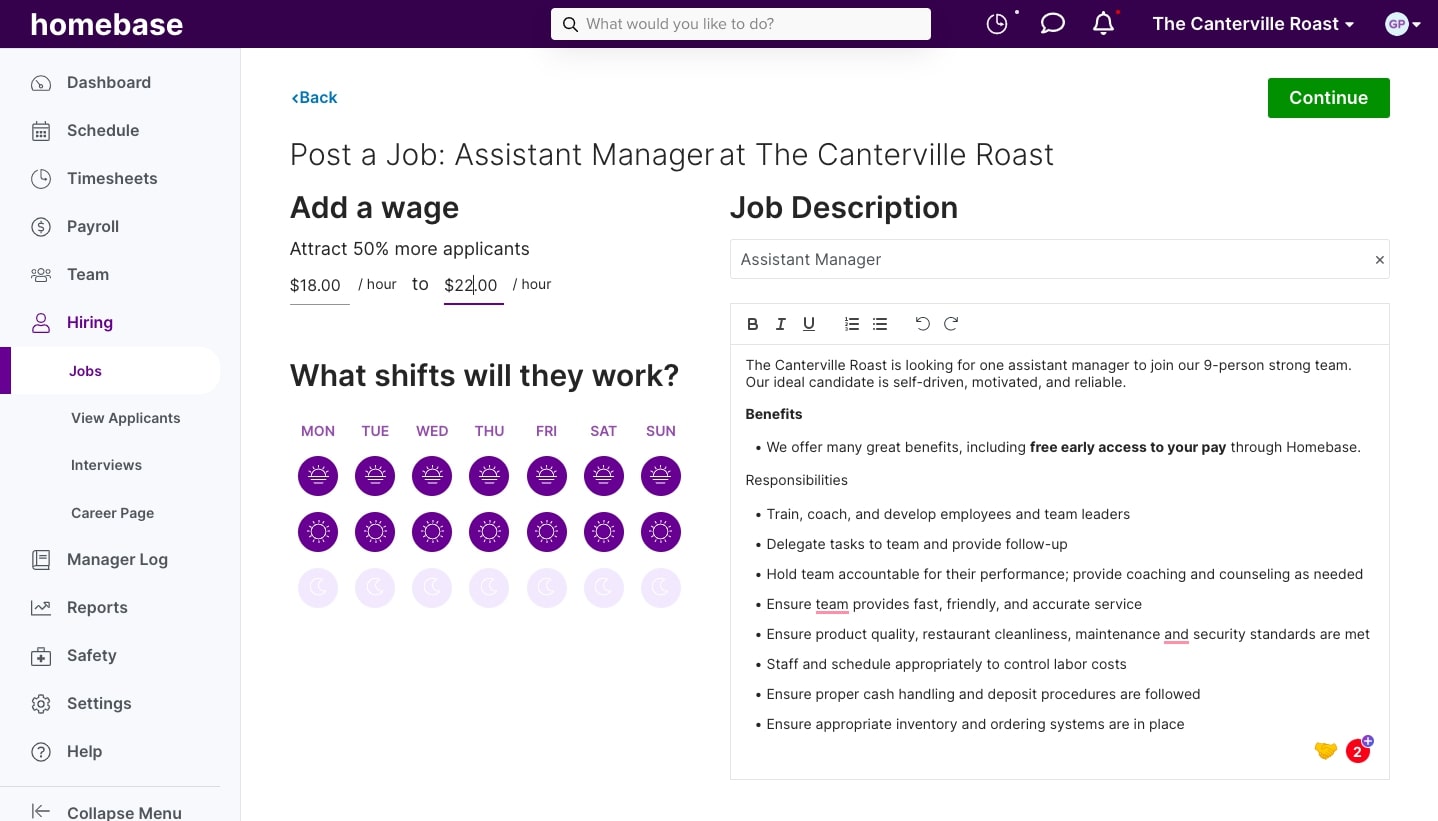When it comes to hiring, small businesses have very little margin for error. If you’ve only got a dozen employees, one wrong hire can profoundly impact the dynamic.
That’s not to mention the time and money you spend on hiring and training their replacement once they leave. As small businesses tend to have small profit margins, you may struggle to absorb the cost.
So, getting hiring right the first time is crucial. That’s why you need a recruitment process that hooks the best candidates and allows you to filter out the unsuitable ones.
Let’s discover the biggest hiring mistakes a small business can make and how to avoid them.
1. Waiting until the last minute
As running a small business demands a lot of time and attention, you may forget about hiring until an employee quits or you get noticeably busier.
The problem is you then have to rush the recruitment process to keep yourself adequately staffed. That means you won’t have time to thoroughly vet candidates and check if they’re a good match. You’ll also have less time for onboarding and training which may leave new hires feeling underprepared.
You’ll also miss all the job searchers who apply earlier and give yourself a smaller candidate pool to choose from.
Predict labor demand
Analytics like Homebase’s labor forecasting tool show you how many staff you normally need at different times of the year. That makes it easier to spot upcoming busy periods and successfully plan your seasonal hires.
2. Hiring only for immediate needs
As people leave or demand grows, you may just hire to fill gaps. But this means you may overlook understaffed shifts or skills and roles your business lacks.
For example, you might hastily replace a bartender when you could really do with a mixologist to outshine the neighboring pub’s cocktail menu.
Do your homework
Checking your current staffing levels will give you a better idea of how many candidates to hire and what skills to look for. You can collect feedback from employees at the end of each shift to gauge how busy they were or what customers were asking for. Homebase has a rating system and comment box so you can spot trends whilst getting specific details.
3. Leaving out important information in the job ad
Your job description gives candidates their first impression of your business. If you’re vague, they might interpret that as a lack of transparency or defined roles and look elsewhere.
Or candidates might apply anyway, get the job, and realize the position doesn’t suit them in their first days or weeks. Let’s say you don’t include anticipated working hours in your ad. Many people dedicate evenings to family and friends and could be frustrated to discover they’re supposed to work late nights for your business.
The result is new hires will either leave early or feel dissatisfied and unengaged.
Write detailed job descriptions
Include the following information in your job ad to help candidates make an informed choice:
- Job title and department
- Responsibilities
- Required experience and qualifications
- Expected working hours and days
- Location
- Pay and benefits
- Your business values
Homebase’s hiring feature has a template library for dozens of popular small business roles to help you get started. All you have to do is fill in wages and anticipated shifts and then tweak the text.

4. Depending on one job site
Relying on one or two job sites limits how many candidates can see, and therefore apply, to your positions. This decreases the likelihood of you finding the top employees.
If you repeatedly hire from one source, you’ll probably end up with employees from the same demographic. For example, a bar that only posts openings on Facebook may find the majority of their applicants are men between 25 and 35. But for your business to thrive, you need a diverse team that will bring different skills, experiences, and perspectives to their roles.
Broaden your search
As well as posting on the top job boards for hourly workers, list your openings on small and niche sites. You can also do the tried and tested methods of hanging a sign in the window, asking for referrals, or attending a job fair.
To get the most eyes on your post, use Homebase’s syndication tool to list across hundreds of job sites. All the applications appear on your hiring dashboard so you can easily manage them in one place. That means you save time flipping through different websites.
5. Having an unpredictable hiring process
When you don’t have a formal recruitment process, you may leave hiring tasks until you’re free. But this can lead to inconsistent correspondence with applicants. So, you might send an immediate confirmation and then wait two weeks to invite the same person to interview.
Applicants may interpret long silences as a lack of interest and get another job in the meantime. Or they may worry your ad-hoc communication style reflects how you run your business and decide they no longer want the role.
Use an applicant tracking system
Dealing with a never-ending flow of CVs and job application forms can be challenging. It’s easy to lose track of when candidates applied and how long they’ve been waiting for a response.
Use Homebase’s applicant tracking system to monitor candidates and see their status. That way you’ll have better oversight of the recruitment process and keep great candidates from slipping through the cracks.
6. Doing most of the talking
While it’s important to educate candidates about the position, you also need to learn more about them. You need to use this time to gauge whether they’re a good fit for your team. If you dominate the conversation — whether that’s because they’re shy or you have a lot to cover — you may not get a good sense of candidates’ personalities.
Structure your interviews
Split your interview into two parts by first questioning the candidate before informing them about your business and the job. That way you’ll give yourself time to sell the role and learn everything you need about the applicant.
If you decide during the question portion that they are a wrong fit, you can end the interview without moving on to the next section and save some time.
7. Skipping checks and references
It’s a mistake to hire based solely on your gut instinct as interviews rarely give you the full picture. For instance, many reserved candidates may warm up quickly to their new colleagues and customers. Likewise, someone who’s enthusiastic in an interview may not be as committed to the role as they seem and leave after a few months.
Conduct a thorough check
References give you a deeper insight into what a candidate would be like as an employee. You can tell whether they’d be a good fit for your culture and where their strengths and weaknesses lie. If candidates can’t provide recent references, that could be a sign they’ve had issues at previous jobs.
Conducting a background check can also give you peace of mind. While most people deserve a second chance for criminal behavior, you should have all the information before you make a decision.
8. Making a single-handed choice
You know your business better than anyone but that doesn’t mean you don’t have blind spots. Behind the scenes, employees may have an insight into who’d be a good addition to your team. Or they may have noticed issues with your previous hiring and staffing decisions.
Involve your team in the hiring decision
Ask your employees for their opinions on your shortlist of applicants and listen to their feedback. If they’re all unimpressed with your top pick, that’s a sign they’re not actually a good fit.
You can also invite employees to interviews so they can assess candidates first-hand. Just be sure to only have one team member present or you’ll risk making the interviewee feel more on the spot and nervous.
9. Misclassifying workers
There are strict classification laws about what pay and benefits different types of workers must receive. If you mislabel an employee as a contractor, and fail to pay them correctly, you could face hefty fines. That’s not to mention the damage to your relationship with employees and your reputation if people believe you’ve acted maliciously.
Seek expert advice
Given how complex labor laws can be, it’s best to seek legal advice if you’re unsure about classification. Homebase has a team of HR professionals who have expertise in federal and state guidelines. They can review your situation and confirm you’ve labeled your staff correctly.
10. Skipping the preboarding phase
Once you’ve offered a candidate the job, the hiring process isn’t over. They still have to sign the contract and turn up to their first shift at your business.
If you neglect the preboarding phase, new hires may begin to feel nervous about what to expect from the role. Perhaps they’ll wonder if your job offer is legitimate. They may be more inclined to accept other offers before you can officially welcome them to the team.
Send paperwork and information in advance
Having new hires complete their paperwork and look over the employee handbook before their first day can reassure them. They’ll see that the job is a sure thing and get more information about your business.
Homebase’s onboarding feature allows you to send documents digitally and get an e-signature from new employees. You can include your own documents like training material and the employee handbook for a more personalized touch.

Avoid hiring mistakes: How Homebase finds you the best candidate every time
Getting recruitment right is critical to success. After all, your hiring process determines who’ll be on your team and shape the direction of your small business. But there are many pitfalls to avoid before you find your ideal candidate.
Homebase can support you through the hiring process. Our hiring and onboarding features have many tools to speed up the search, filter out unsuitable hires, and make the best possible impression on your top choices.
With Homebase, you can:
- Create professional job adverts
- Share posts across hundreds of sites
- Ask screener questions
- Track applicants process
- Onboard new hires properly
That way you know you’ve got the best possible people for the job and they don’t have any doubts as they arrive for their first day.
Frequently asked questions about hiring mistakes
How do you know how many employees you’ll need to hire?
You can know how many employees you’ll need to hire by looking at historic labor demand. Homebase’s predictive tool can perform this task automatically for you and display the amount at the bottom of your schedule. You can also collect feedback from team members to see if any shifts have gotten busier or quieter lately and require different staffing levels.
How do you select the right legal classification for a new employee?
You can select the right legal classification for a new employee by seeking expert legal advice. For instance, Homebase has dedicated professionals you can talk to directly about state and federal laws. That way you can confirm whether you’ve classified workers correctly and avoid any fines for noncompliance.
What paperwork is required before a new employee can start work?
The following paperwork is required before a new employee can start work:
- A W-4 form for tax withholdings
- An I-9 form to verify the worker’s eligibility to work in the US
- A signed contract
- A direct deposit authorization form
- Emergency contact information
Some industries like healthcare and government may need more forms. Experts like Homebase’s team of HR professionals can advise you on the exact paperwork you need to avoid compliance issues and fines.
